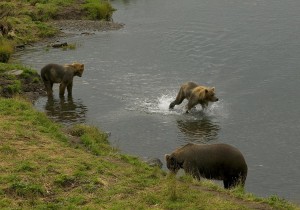 Although they are saddled with a number of colorful regional or appearance-derived names, we only really have two true species of bears and a genetic anomaly in Cascadia: the brown bear, the black bear and the so-called ABC bears.
Although they are saddled with a number of colorful regional or appearance-derived names, we only really have two true species of bears and a genetic anomaly in Cascadia: the brown bear, the black bear and the so-called ABC bears.
Brown bears
These large bears often known for their location (Kodiak bears) or coloration (grizzly bears) are all really brown bears which are arguably the largest land-based predators on the Planet. In general, the coastal bears are larger typically identified as brown bears and the inland bears which are smaller are referred to as grizzly bears. While some brown bear populations in Alaska are healthy—the bears in Katmai National Park being an example—brown bear populations in Cascadia are generally heavily managed, at risk from hunting or habitat issues, or missing all together. We are most concerned about logging and other natural resource development, trophy hunting pressure and control actions that are driving population trends downward or are inhibiting re-colonization or recovery—grizzlies are listed as threatened under the Endangered Species Act south of the US-Canadian border—in areas like the northern Cascades of Washington State.
Black bears
Brown and black bears have been separate species for about 5 million years. These smaller and more numerous bears occur throughout Cascadia with the exception of some non-forested areas of central Washington and Oregon. These bears are numerous in areas free from human disturbance and less numerous or absent in areas where habitat destruction has occurred, hunting pressure is significant or control actions are allowed. We are particularly concerned about whether or not decisions regarding hunting or control actions are informed by population monitoring and oversight.
The ABC bears
The ABC bears found only on Admiralty, Baranof and Chichagof Islands in the Tongass National Forest have long been a mystery because they are not quite wholly brown bears and have a little bit of polar bear in their makeup. The old story was that the ABC bears might be an ancestor to both brown bears and polar bears—something of a missing link. New research from UC Santa Cruz indicates that these bears which have polar bear mitochondrial DNA—cellular DNA that is passed down mother to mother; brown bear DNA in most of their chromosomes; and a small percentage of polar bear DNA in their so-called X chromosome are actually the product of a female polar bear mating with a male brown bear at the end of the last Ice Age about 10,000 years ago. These bears are important and subject to the same pressures as other coastal brown bears.
Recent posts on this topic:
